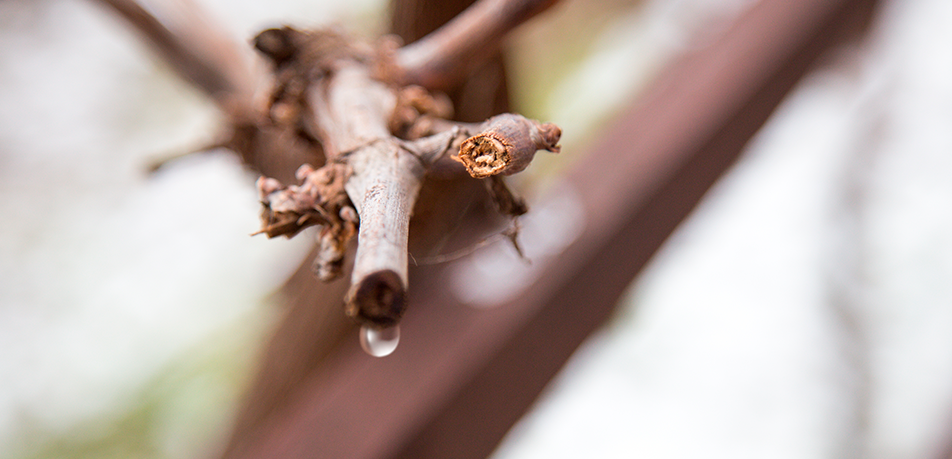Sap Bleeding

Blood and tears mark the beginning of every promising new life. Much like a newborn cries at birth, the vine awakens from its long winter slumber by “shedding tears”[1] or “bleeding” from its pruning wounds.
The vine's physiology is ancient and wise and full of surprises. The bleeding can last up to four weeks.
So, how exactly does the vine come back to life?
Sap bleeding marks the moment when the plant's root system reactivates after winter dormancy. This is when the vine awakens to a new life:
Cellular respiration activates; the ability to absorb water and nutrients returns. The vine is now ready to start its growth cycle.
[[{"fid":"16627","view_mode":"default","fields":{"format":"default","alignment":"","field_file_image_alt_text[und][0][value]":false,"field_file_image_title_text[und][0][value]":false},"type":"media","field_deltas":{"2":{"format":"default","alignment":"","field_file_image_alt_text[und][0][value]":false,"field_file_image_title_text[und][0][value]":false}},"link_text":null,"attributes":{"height":480,"width":480,"class":"media-element file-default","data-delta":"2"}}]]
Soon root pressure increases. The sap rises in the plant and eventually seeps out of the pruning wounds. Metaphorically speaking, the flow of sap can be compared to blood circulating through the human body.
It should be mentioned that the bleeding sap is far richer in organic compounds (sugars and acids) than the xylem sap that circulates through the vine during the growth cycle, which contains fewer minerals.
Interestingly, sap bleeding does not seem to affect the vine's physiological development in any significant way. In fact, there is no correlation between the amount of bleeding and a weakening of the plant, although it can present certain inconveniences:
- An increased susceptibility to spring frost, because the bleeding sap rehydrates the buds.
- Sap bleeding can also interfere with the development of connective tissue in field grafts. It is therefore best to head back the vine's rootstock several days prior to grafting.
Bleeding is the dramatic, but necessary end result, which results from a build-up of bacteria produced by the sap, a viscous substance that plugs the xylem vessels and feeds future shoots.
This is when budbreak awaits the beginning of spring. When the time comes, the buds begin to swell and the first shoots emerge, announcing a new life that will ultimately fill our glasses and memory.
The vine once again presents us with a perfect analogy for the evolution and existence of human life: the lifeblood that welcomes it into this world promises a future that is simultaneously essential and earthly and magical. An expression of Life at its purest and most beautiful.
[1] TN: In Spanish, “sap bleeding” is known as el lloro (weeping) and the “bleeding” is described as lágrimas (tears).
